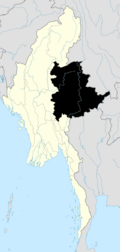Kutkai
Kutkai
ကွတ်ခိုင် | |
|---|---|
Town | |
MST ) |
Kutkai (
History
In the early 20th century, the area around Kutkai was explored by British botanists. In 1912, Stephenson documented that he had found the earthworm species Pheretima molesta of the genus Pheretima in Katkai.[3]
Shan State became a major Christian area of Burma in the mid-19th century.[4] Kutkai was an important centre for the Kachin Baptist Church and was visited by missionaries, notably Baptist Reverend George J. Geis in the 1930s and Gustaf A. Sword from 1936 to 1942.[5][6] Geis died in Kutkai on October 28, 1936 whilst he was working there at the Kachin Bible Training School he had established.[7]

During
In July 1954, Hoo Kya Chin, a Kokang businessman from Mu Kwan was arrested by the immigration officials in Kutkai for not carrying an identification card which caused some controversy in the region.[10]
In the 1980s, two privates and a sergeant of the Kachin Independence Army insurgent 4th Brigade surrendered at Kutkai garrison.[11]
On 7 January 2024, the town was captured by the Three Brotherhood Alliance from the State Administration Council during Operation 1027, an offensive launched during the Civil War.[12]
Geography

Kutkai is situated in eastern-central Burma, several kilometres by road north of
It sits on Mandalay-Lashio-Muse road aka Asian Highway route 14 (
Economy
As with many parts of Burma, the economy relies on agriculture, particularly rice production. Villagers in Kutkai Township are generally well educated in farming practices and in canning-bottling.[14] Of major note is the Kutkai Market in the town where people come from miles to sell their goods. Kutkai High School is located in the southern part of the town. The town also contains the Kutkai General Hospital.
In the 1990s, Kutkai township was exposed as a major raw
References
- ^ Google Maps (Map). Google.
- ^ Bing Maps (Map). Microsoft and Harris Corporation Earthstar Geographics LLC.
- ^ Records of the Indian Museum, Volume 34. Indian Museum, (Calcutta, India), Zoological Survey of India, The Museum; Manager of Publications, Govt. of India Press. 1932. p. 435.
- ^ "History of Shan Churches" (PDF). Shan Missions. Retrieved November 8, 2010.
- ISBN 0-87808-416-9.
- ISBN 90-04-05882-6.
- ^ Annual report ... American Baptist Foreign Mission Society. 1937. p. 54.
- ISBN 978-0-8160-6297-3.
- ISBN 978-0-16-088231-9.
- ISBN 978-0-646-32859-1.
- ^ Summary of world broadcasts: Far East, Part 3. Monitoring Service of the British Broadcasting Corp. 1987.
- ^ "Myanmar's Brotherhood Alliance Seizes Two More Towns in Shan State".
- ^ "Welcome to MRTV-3". Archived from the original on 2011-09-29. Retrieved 2011-06-20.
- ISBN 1-56000-861-X.
- ^ "Current Projects of OSS-101 Association, Inc". OSS. Retrieved November 8, 2010.
- ^ "Opium, arms seized in Kutkai". Burma Library. August 18, 1999. Retrieved November 8, 2010.
- The New Light of Myanmar. August 14, 2003. Archived from the originalon 2005-01-29. Retrieved November 8, 2010.


